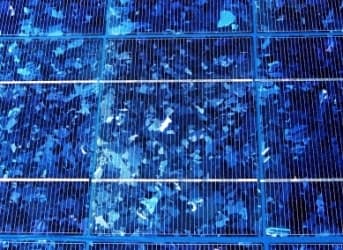Toxic sludge and filthy air - byproducts of the oil and coal industries - are a constant irritant for opponents and even proponents of fossil fuels, while renewables like wind and solar are often seen as bastions of rectitude for their relative cleanliness.
However, before the proponents of solar energy can claim the moral high ground, they may need to deal with an inconvenient truth of their own: mountains of hazardous waste being created by the production of solar panels.
Sodium hydroxide and hydrofluoric acid are among the caustic chemicals required in the manufacturing process, along with water and electricity, the production of which emits greenhouse gases. Metals that go into solar panels are often mined in jurisdictions with low environmental standards and even poorer safety records.
The biggest problem, though, is waste. The Silicon Valley Toxics Coalition (SVTC), a San Francisco-based non-profit, has been tracking the waste created by solar panel manufacturers since 1982, and reports a disturbing upward trend in the amounts being generated annually. Related: Bankruptcies Starting To Pile Up In Coal Industry
“We need to take action now to reduce the use of toxic chemicals in [photovoltaic production], develop responsible recycling systems and protect workers throughout the global PV supply chain,” the coalition said in its latest report.
The SVTC produces an annual scorecard rating solar companies for their commitment to, among other things, the environment, transparency and workers' rights. Last year Trina occupied the “sunniest” position on the list, while the “cloudiest” ranking went to JA Solar.
In a sense, the problem is a byproduct of the industry's success; fueled by government incentives, production of solar panels has skyrocketed in recent years, and in the process, millions of pounds of polluted sludge and contaminated water have also been produced.
Disposing of the waste by truck is expensive, so in the absence of regulations, it gets dumped where it shouldn't. The most egregious example is, unsurprisingly, in China, where until recently solar panel makers simply dumped silicon tetrachloride on fields near their factories, according to a 2013 news report. Related: Is This Quietly Becoming The World's Best Place To Drill For Oil?
Local protests and legal action ensued when panel manufacturer Jinko Solar was accused of dumping toxic waste into a nearby river. The Chinese government now requires panel makers to recycle most of their waste, but it is unclear to what extent the rules are enforced in a country notorious for slack environmental oversight.
The situation is better in the United States and Europe, where there are laws in place governing the disposal of toxic wastewater and hazardous e-waste. California, the leading market for consumer-based solar, passed regulations in the 1970s requiring solar panel makers to report the amount of waste they produce and where they send it.
However, data from the California Department of Toxic Substances Control showed that of 41 solar panel manufacturers in the state (2013 numbers), only 17 reported waste. Those that did report, produced 46.5 million pounds of sludge and contaminated water from 2007 to 2011, according to The Financial Post. This includes 12.5 million pounds of hazardous waste from now-defunct Solyndra.
While most of the waste stayed in the state, some of it was exported to other jurisdictions, which brings in another ugly truth behind toxic solar waste: the emissions created by its disposal. Related: Schlumberger Vs. Halliburton: Which Is The Better Buy Right Now?
Dustin Mulvaney, an environmental studies professor quoted by the FP, states that after installing a solar panel, “it would take one to three months of generating electricity to pay off the energy invested in driving those hazardous waste emissions out of state.”
But considering all the metals contained in solar panels, of which there are 16 according to the Minerals Education Coalition, why aren't the materials recycled?
The problem is one of supply and demand: not enough facilities to recycle solar panels and too few solar panels that have reached the end of their lives. In short, there's no market for it - at least, not yet.
Without recycling, panel manufacturers have no other choice than disposal, and they are left largely to their own devices as far as reporting their waste and dumping it properly. Kind of a scary thought, considering the proliferation of solar panels and the wholesome reputation they currently have in the minds of the public, compared to fossil fuels. The problem with oil is that it spills. For solar, the issue seems to be, who is flying under the radar when it comes to toxic waste disposal?
By Andrew Topf of Oilprice.com
More Top Reads From Oilprice.com:
- A New Oil Spill Disaster Waiting To Happen In The Gulf
- Can U.S. Nuclear Plants Operate For 80 Years?
- MLPs Under Threat From The IRS


















